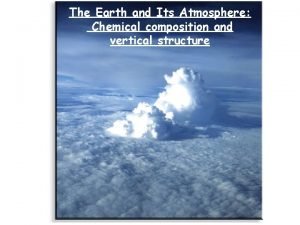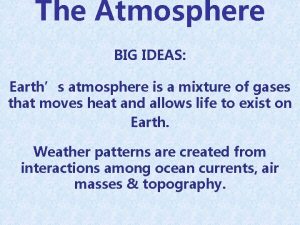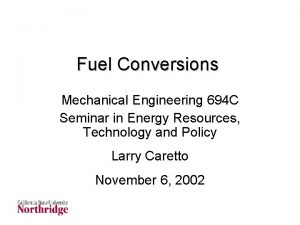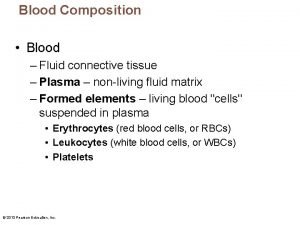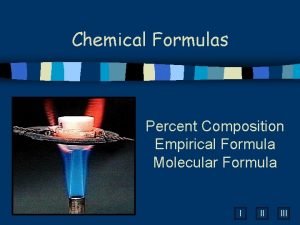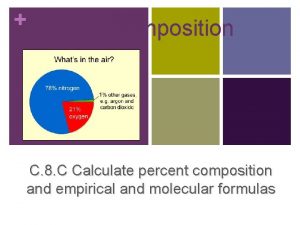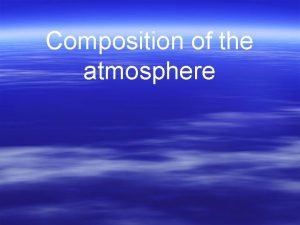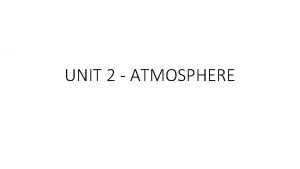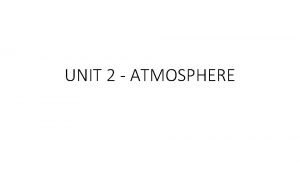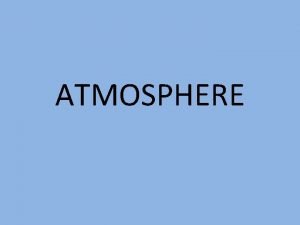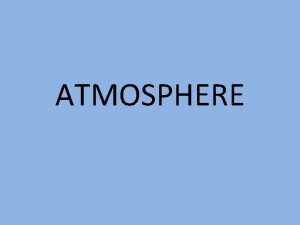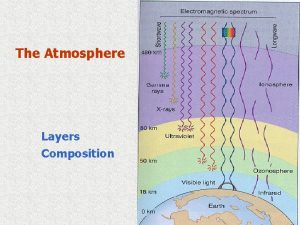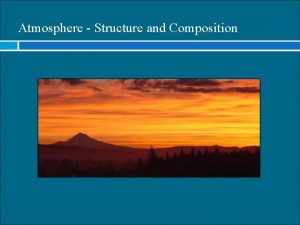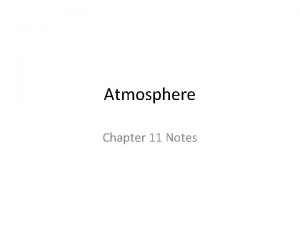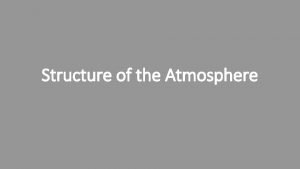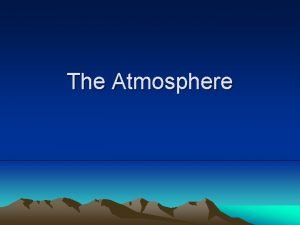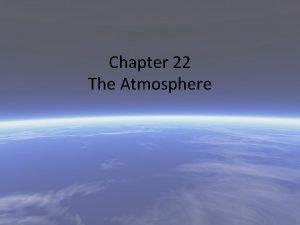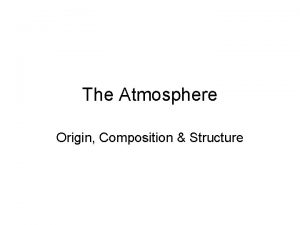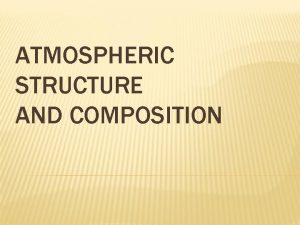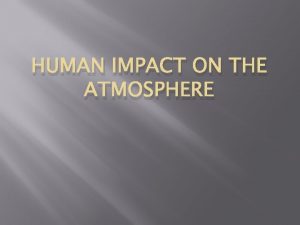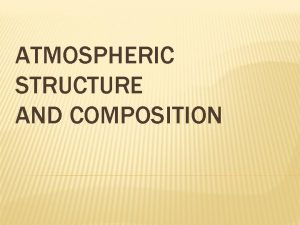THE ATMOSPHERE Composition of the Atmosphere The atmosphere
























































- Slides: 56

THE ATMOSPHERE

Composition of the Atmosphere �The atmosphere is made up of “air” �Air is a solution of different gases �Nitrogen - 78% �Oxygen - 21% �Water Vapor – 0 to 4% �Carbon Dioxide -. 037% �Other gases make up the rest �Notice that the first two make up about 99% of air

Water vapour � The air on Earth contains water in gas and vapour form �Water vapour is actually made up of very tiny drops of liquid water (clouds) �water gas is invisible (a single molecule of water)

Ozone � Ozone is a chemical that is formed when UV light interacts with the oxygen molecules in the atmosphere. �This protects us from most of the harmful UV rays that the sun produces. �Chemicals called CFC’s interrupt this process and cause ozone to be broken down

The ozone hole

The ozone holes tend to form over the poles because of ice in the upper atmosphere.

Other solid stuff � Dust � Salt crystals � Soot � Bacteria � Pollen �All of these things help form clouds by giving the water vapour something to stick to

Structure of the Atmosphere There are four main layers in the atmosphere that are based upon temperature changes

Troposphere � Thicker at equator than it is at the poles � This is where all weather happens � As you go higher the temperature drops � Top is called the tropopause

Stratosphere � Clear, dry air � No real weather � As you go higher the temperature increases because of ozone reactions � Ozone layer is found here � Top is called the stratopause

Mesosphere � Temperatures drop again

Thermosphere � Temperatures rise again because of solar radiation

Heating the Atmosphere � There are three ways that heat is transferred � 1) radiation – the way that heat gets to Earth from the Sun � 2) Conduction – when hot things touch cool things heat flows from HOT COLD � 3) Convection – warm fluids (air) is less dense than cool, so warm rises and cool falls

Heat balance � All of the energy coming in from the Sun (solar radiation or insolation) must leave the Earth at some point �It needs to be BALANCED � About half of the energy is absorbed by the ground �The rest is absorbed by the atmosphere, reflected back into space, or radiated away.


The greenhouse effect � When the ground radiates (gets rid of) the energy it has absorbed the infrared energy should just pass through the atmosphere �Because of water vapour, carbon dioxide and methane this does not always happen.

Why it gets colder as you climb � As you get higher up in the atmosphere, there is less atmosphere above you so the pressure is lower. �Because of this, the molecules are farther apart and they bump into each other less = lower temperature � Temperature drops 1 o C for every 160 m in altitude

Effect of seasons � Because the Earth is tilted, during different seasons the Sun is at different angles. �In the summer the angle is large �In the winter the angle is small

Other things that affect absorption of solar radiation � Dark coloured things tend to absorb more than light coloured things � Land heats quicker than water, and cools quicker than water

Humidity � There are two types of Humidity � 1) specific humidity �The actual mass of water present – gwater /kgair � 2)relative humidity � amount of water present as a percent of what it can hold. � As the air gets warmer it can hold more water


Condensation � In order for water vapour to condense air must cool down �Ways this can happen � 1) air comes in contact with a colder surface �Ex – dew & frost � 2) air radiates heat away – ex fog � 3) air mixes with colder air – ex fog � 4) as it rises, it expands and cools – ex clouds

Clouds � Clouds are made of condensed water droplets or ice particles � Some clouds form in layers while others form as tufts �Layers = stratiform �Tufts = cumuliform � There are different names for clouds based upon their shape and height in the atmosphere.

Cloud names � There are three types of clouds � 1) cirrus type clouds �Ice crystals very high in the atmosphere � 2) Stratus type clouds �Low sheets (layers) of clouds � 3) Cumulus type clouds �Puffy clouds formed by vertical movement of air

Prefixes � 1) cirro = highest (made of ice crystals) � 2) alto = middle � 3) nimbo = rain �These prefixes are combined with the cloud types to name different clouds.

Cloud types

How clouds form � If air is warmer it is less dense. �If the warm air also contains moisture, as it rises the water vapour will condense to form clouds �It condenses because the surrounding air is cooler and therefore can hold less water (relative humidity is too high so water condenses) � Anything that causes air to be lifted will cause clouds to be formed

Where does it rain? � There are three places that it will rain a lot � 1) On the windward side of mountains �As the air is pushed against the mountain by the wind, it will rise up, and the water will condense forming rain � 2) Storm areas �Areas where there is a lot of moisture and a lot of heat � 3) The equator �Since the winds converge there the air has to go up

Where does it not rain? � The opposite of the above �Anywhere air is sinking from above �On the leeward side of mountains (rainshadow effect) �Zones of colder sinking air �Where winds diverge


Where does the water come from? � The water cycle �A) Water evaporates over the oceans �Is pushed over land �B) Humid air rises and condenses �C) Precipitation (rain and snow) �E) Runoff OR D) filter into ground water

Pressure � Air pressure is the force of the column of air above us pushing in all directions � There are two types of pressure systems that we will talk about here � 1) high pressures �Pressure is higher than normal � 2) low pressures �Pressure is lower than normal

High pressure systems � In a high pressure system the air is sinking from above �This means that it is cold and dry air that will be heated up as it falls �Dry air means good sunny weather �But this can also mean the trapping of dust and pollution

Low pressure systems � In a low pressure system, the air is rising – that means clouds and rain �Low pressure systems are usually created by a warm air mass pushing a cold dry one out of the way �Humid air is also less dense than dry air so air from the ocean will rise up and cause a low pressure

Pressure Gradient Wind � What happens when you open a pop bottle? �Air rushes out because it is under pressure. �It will flow from high pressure to low pressure � The same thing happens with the air masses in the atmosphere �Wind comes from air rushing from high pressure to low pressure �The bigger the difference in pressure the stronger the wind!


Local wind � There also smaller scale winds that only act over a small area �One is the seabreeze – landbreeze system � A seabreeze happens because the sun heats up the land cool air from the ocean replaces it – happens during the day � A land breeze happens because the land cools off faster at night and the ocean is now warmer than the land

Climate � Climate is the total of many factors �Temperature �Precipitation �Wind directions/strength �All of these are influenced by the sun

The importance of the Sun � The sun is the single most important element that determines the climate of an area �The sun not only gives an area its temperature, but also determines how much rain falls.

Fronts – the boundary between air masses � Air masses are large masses of air that have the same weather (temperature/humidity) �If the difference between air masses is great there will be a major change in the weather �Example – if there is a very cold air mass meeting a warm air mass �Since the cold air is much more dense it will slide under the warm air and push it upwards. � Whenever there is a front there is almost always rain

The 4 Types of fronts � � The name of a front depends on which air mass is moving 1) Cold front � The cold air is moving into warm air and displacing it � 2) Warm front � The warm air is pushing cold air out of the way � 3) Stationary front � There is no movement � 4) Occluded front � The cold front has wrapped around – three day storm

Symbols for the different fronts � There are different weather map symbols for each type of front �The side that the “bumps” are on shows the direction of movement

Cold front vs. Warm Front Cold front weather � Cold fronts are steep and move faster than warm fronts � Because of this, they lift warm, moist air quickly forming thunderstorms and heavy rain Warm front weather � Warm fronts are less steep and move slower than cold fronts � In these fronts the warm air climbs slowly over the cold air so layered clouds and light rain develops


High vs. Low pressure system Weather in a High � Since air is sinking from above it is dry � This means clear sunny weather with no clouds or small cumulus “happy clouds” � Weak winds Weather in a Low � Since air is rising and water condensing � Lots of cloud cover � Drizzle and rain showers � Strong winds

Thunderstorms � Thunderstorms are formed from cumulonimbus clouds and have a strong upward and downward movements inside them from rising humid air. �Always have lightning and thunder associated �They are usually about 10 -20 km across �Heavy rain and gust fronts are also a characteristic

How they form � Thunderstorms form whenever warm moist air rises very quickly and the condensation of water releases more and more heat so it rises faster and faster. �These clouds appear to explode upwards �Once the air gets high enough it cools quickly and falls back to the earth very fast �This leads to a gust front – a cold blast of air that rushes out of the front of a thunderstorm

Thunderstorm anatomy

Lightning � Lightning is a very large discharge of static electricity �Temperatures inside the bolt can reach 28 0000 C �This high temperature superheats the air creating a shockwave that sounds like thunder

Tornado!!! � A tornado is a swirling wind that forms when air rises under a thunderstorm and starts to swirl because changing wind directions �They are very destructive locally (small areas) �Usually less than 500 m across at the ground �Wind speeds vary with intensity �Not to be confused with the dust devil � How a tornado forms

The Fujita Scale � This is a scale used to describe the destructive power of a tornado

Hurricanes � Hurricanes are the most destructive storms we know of because … �They have very high winds �The storm surge �Made up of thunderstorms that can have tornados once the storm makes landfall

Hurricane anatomy � A hurricane is a swirling group of thunderstorms � At the centre is an “eye” �The eye is a calm area where there is little wind and no rain – it is formed from sinking air dumped out of the top of the thunderstorm filled “eye wall” � Hurricane anatomy

Hurricane formation � They are formed when a low pressure is formed over the ocean and is intensified by condensing water vapour �As water condenses is releases energy that feeds the storm �Because is it a swirling group of thunderstorms, it drops lots of rain and hail and can have very high winds �These winds and the low pressure lead to the storm surge

The storm surge � There are two reasons for storm surge � 1) low pressure sucks the sea level up in the eye � 2) winds drive the water up against the land �Storm surges can make sea level be 20+ feet higher than normal � Storm surges are responsible for most of the damage and can flood entire regions

That’s all folks � No more notes in the course!!!
 Structure of atmosphere
Structure of atmosphere Hsocl
Hsocl Atmosphere ideas
Atmosphere ideas Vẽ hình chiếu vuông góc của vật thể sau
Vẽ hình chiếu vuông góc của vật thể sau Cong thức tính động năng
Cong thức tính động năng 101012 bằng
101012 bằng Tỉ lệ cơ thể trẻ em
Tỉ lệ cơ thể trẻ em Thế nào là mạng điện lắp đặt kiểu nổi
Thế nào là mạng điện lắp đặt kiểu nổi Lời thề hippocrates
Lời thề hippocrates Vẽ hình chiếu đứng bằng cạnh của vật thể
Vẽ hình chiếu đứng bằng cạnh của vật thể đại từ thay thế
đại từ thay thế Quá trình desamine hóa có thể tạo ra
Quá trình desamine hóa có thể tạo ra Môn thể thao bắt đầu bằng từ chạy
Môn thể thao bắt đầu bằng từ chạy Sự nuôi và dạy con của hổ
Sự nuôi và dạy con của hổ Hát kết hợp bộ gõ cơ thể
Hát kết hợp bộ gõ cơ thể Dạng đột biến một nhiễm là
Dạng đột biến một nhiễm là Biện pháp chống mỏi cơ
Biện pháp chống mỏi cơ Trời xanh đây là của chúng ta thể thơ
Trời xanh đây là của chúng ta thể thơ Phản ứng thế ankan
Phản ứng thế ankan Gấu đi như thế nào
Gấu đi như thế nào Thiếu nhi thế giới liên hoan
Thiếu nhi thế giới liên hoan Phối cảnh
Phối cảnh điện thế nghỉ
điện thế nghỉ Một số thể thơ truyền thống
Một số thể thơ truyền thống Thế nào là hệ số cao nhất
Thế nào là hệ số cao nhất Hệ hô hấp
Hệ hô hấp Các số nguyên tố là gì
Các số nguyên tố là gì đặc điểm cơ thể của người tối cổ
đặc điểm cơ thể của người tối cổ Các châu lục và đại dương trên thế giới
Các châu lục và đại dương trên thế giới Chụp tư thế worms-breton
Chụp tư thế worms-breton ưu thế lai là gì
ưu thế lai là gì Thẻ vin
Thẻ vin Tư thế ngồi viết
Tư thế ngồi viết Cái miệng nó xinh thế
Cái miệng nó xinh thế Các châu lục và đại dương trên thế giới
Các châu lục và đại dương trên thế giới Cách giải mật thư tọa độ
Cách giải mật thư tọa độ Bổ thể
Bổ thể Từ ngữ thể hiện lòng nhân hậu
Từ ngữ thể hiện lòng nhân hậu Tư thế ngồi viết
Tư thế ngồi viết Ví dụ giọng cùng tên
Ví dụ giọng cùng tên Thơ thất ngôn tứ tuyệt đường luật
Thơ thất ngôn tứ tuyệt đường luật Bài hát chúa yêu trần thế alleluia
Bài hát chúa yêu trần thế alleluia Sự nuôi và dạy con của hươu
Sự nuôi và dạy con của hươu Diễn thế sinh thái là
Diễn thế sinh thái là Syngas composition
Syngas composition Composition of la
Composition of la Which design principle involves mentally dividing
Which design principle involves mentally dividing Composition of matter chapter 9
Composition of matter chapter 9 Nonliving fluid matrix
Nonliving fluid matrix The language of composition
The language of composition Photography elements and principles
Photography elements and principles Gun powder composition
Gun powder composition Percentage composition of h2o
Percentage composition of h2o Unit 3 nutrition lesson 4 weight control
Unit 3 nutrition lesson 4 weight control Percent composition
Percent composition Intended message
Intended message
